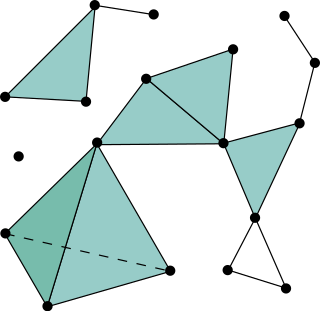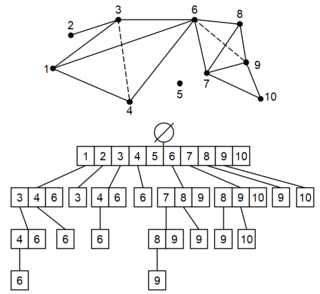
In geometry, a simplex is a generalization of the notion of a triangle or tetrahedron to arbitrary dimensions. The simplex is so-named because it represents the simplest possible polytope in any given dimension. For example,
In mathematics, a chain complex is an algebraic structure that consists of a sequence of abelian groups and a sequence of homomorphisms between consecutive groups such that the image of each homomorphism is included in the kernel of the next. Associated to a chain complex is its homology, which describes how the images are included in the kernels.
In mathematics, homology is a general way of associating a sequence of algebraic objects, such as abelian groups or modules, with other mathematical objects such as topological spaces. Homology groups were originally defined in algebraic topology. Similar constructions are available in a wide variety of other contexts, such as abstract algebra, groups, Lie algebras, Galois theory, and algebraic geometry.
In mathematics, and more specifically in algebraic topology and polyhedral combinatorics, the Euler characteristic is a topological invariant, a number that describes a topological space's shape or structure regardless of the way it is bent. It is commonly denoted by .
In algebraic topology, a k-chain is a formal linear combination of the k-cells in a cell complex. In simplicial complexes, k-chains are combinations of k-simplices, but not necessarily connected. Chains are used in homology; the elements of a homology group are equivalence classes of chains.

In mathematics, a simplicial complex is a set composed of points, line segments, triangles, and their n-dimensional counterparts. Simplicial complexes should not be confused with the more abstract notion of a simplicial set appearing in modern simplicial homotopy theory. The purely combinatorial counterpart to a simplicial complex is an abstract simplicial complex. To distinguish a simplicial complex from an abstract simplicial complex, the former is often called a geometric simplicial complex.
In the mathematical disciplines of topology and geometry, an orbifold is a generalization of a manifold. Roughly speaking, an orbifold is a topological space which is locally a finite group quotient of a Euclidean space.
In algebraic topology, singular homology refers to the study of a certain set of algebraic invariants of a topological space X, the so-called homology groups Intuitively, singular homology counts, for each dimension n, the n-dimensional holes of a space. Singular homology is a particular example of a homology theory, which has now grown to be a rather broad collection of theories. Of the various theories, it is perhaps one of the simpler ones to understand, being built on fairly concrete constructions.

In mathematics, the barycentric subdivision is a standard way to subdivide a given simplex into smaller ones. Its extension on simplicial complexes is a canonical method to refine them. Therefore, the barycentric subdivision is an important tool in algebraic topology.
In algebraic topology, a homology sphere is an n-manifold X having the homology groups of an n-sphere, for some integer . That is,

In combinatorics, an abstract simplicial complex (ASC), often called an abstract complex or just a complex, is a family of sets that is closed under taking subsets, i.e., every subset of a set in the family is also in the family. It is a purely combinatorial description of the geometric notion of a simplicial complex. For example, in a 2-dimensional simplicial complex, the sets in the family are the triangles, their edges, and their vertices.
In mathematics, real projective space, denoted or is the topological space of lines passing through the origin 0 in the real space It is a compact, smooth manifold of dimension n, and is a special case of a Grassmannian space.
In mathematics, a simplicial set is an object composed of simplices in a specific way. Simplicial sets are higher-dimensional generalizations of directed graphs, partially ordered sets and categories. Formally, a simplicial set may be defined as a contravariant functor from the simplex category to the category of sets. Simplicial sets were introduced in 1950 by Samuel Eilenberg and Joseph A. Zilber.

In mathematics, triangulation describes the replacement of topological spaces by piecewise linear spaces, i.e. the choice of a homeomorphism in a suitable simplicial complex. Spaces being homeomorphic to a simplicial complex are called triangulable. Triangulation has various uses in different branches of mathematics, for instance in algebraic topology, in complex analysis or in modeling.

Clique complexes, independence complexes, flag complexes, Whitney complexes and conformal hypergraphs are closely related mathematical objects in graph theory and geometric topology that each describe the cliques of an undirected graph.
A simplicial map is a function between two simplicial complexes, with the property that the images of the vertices of a simplex always span a simplex. Simplicial maps can be used to approximate continuous functions between topological spaces that can be triangulated; this is formalized by the simplicial approximation theorem.
In mathematics, the free factor complex is a free group counterpart of the notion of the curve complex of a finite type surface. The free factor complex was originally introduced in a 1998 paper of Allen Hatcher and Karen Vogtmann. Like the curve complex, the free factor complex is known to be Gromov-hyperbolic. The free factor complex plays a significant role in the study of large-scale geometry of .
Discrete calculus or the calculus of discrete functions, is the mathematical study of incremental change, in the same way that geometry is the study of shape and algebra is the study of generalizations of arithmetic operations. The word calculus is a Latin word, meaning originally "small pebble"; as such pebbles were used for calculation, the meaning of the word has evolved and today usually means a method of computation. Meanwhile, calculus, originally called infinitesimal calculus or "the calculus of infinitesimals", is the study of continuous change.
In algebraic topology and graph theory, graph homology describes the homology groups of a graph, where the graph is considered as a topological space. It formalizes the idea of the number of "holes" in the graph. It is a special case of a simplicial homology, as a graph is a special case of a simplicial complex. Since a finite graph is a 1-complex, the only non-trivial homology groups are the 0-th group and the 1-th group.

In topological data analysis, a simplex tree is a type of trie used to represent efficiently any general simplicial complex. Through its nodes, this data structure notably explicitly represents all the simplices. Its flexible structure allows implementation of many basic operations useful to computing persistent homology. This data structure was invented by Jean-Daniel Boissonnat and Clément Maria in 2014, in the article The Simplex Tree: An Efficient Data Structure for General Simplicial Complexes. This data structure offers efficient operations on sparse simplicial complexes. For dense or maximal simplices, Skeleton-Blocker representations or Toplex Map representations are used.


























